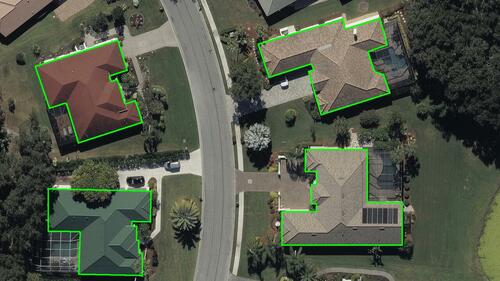

Insurers Spy On Houses Via Aerial Imagery, Seeking Reasons To Cancel Coverage
Insurance companies across the country are using satellites, drones, manned airplanes and even high-altitude balloons to spy on properties they cover with homeowners policies — and using the findings to drop customers, often without giving any opportunity to address alleged shortcomings.
“We’ve seen a dramatic increase across the country in reports from consumers who’ve been dropped by their insurers on the basis of an aerial image,” United Policyholders executive director Amy Bach tell the Wall Street Journal. Reasons can range from shoddy roofing to yard clutter and undeclared trampolines.
Much of this surveillance is done via the Geospatial Insurance Consortium, which boasts of its coverage of 99% of the US population.
 The Geospatial Insurance Consortium provides imagery insurers use to study roof condition and look for risky property attributes (via GIC)
The Geospatial Insurance Consortium provides imagery insurers use to study roof condition and look for risky property attributes (via GIC)In pitching its ability to provide high-resolution „imagery and insights” for property reviews, GIC says insurers can use the service to „review risk and exposure on a building such as proximity of vegetation to the structure, whether a roof needs updating, and verify the exact location for a policy.”
“If your roof is 20 years old and one hailstorm is going to take it off, you should pay more than somebody with a brand new roof,” Allstate CEO Tom Willson told the Journal, unapologetically and ominously adding that, where the company’s use of digital imagery is concerned, „there’s even more to come.”
Wilson framed aerial spying as a pricing issue, but many consumers are finding that companies are using it to suddenly drop their coverage altogether.
The Journal describes the experience of northern California resident Cindy Picos, who was dropped by CSAA Insurance last month, with the company saying aerial imagery revealed that her roof had aged beyond its life expectancy. She paid for an inspection of her own, which found the roof was good for another decade. CSAA wasn’t impressed, and said its decision was final. The firm also refused to share its photos, though it now says it’s changed that policy and will let customers see them — if they ask.
Another Californian, CJ Sveen, was dropped by AAA Homeowners Insurance after their reconnaissance discovered „clutter” in his yard. An indignant Sveen told ABC7 that he uses his yard as a workshop „Apparently they have some pictures and they noticed clutter. I find that offensive. How dare you judge me because of my stuff!”
In AAA’s defense, clutter isn’t just about aesthetics. It could present a fire hazard, attract rodents that harm the structure, present a physical danger to visitors, and obstruct firefighters’ ability to quickly contain a fire at the premises.
 Would you cover this house? CJ Sveen’s homeowners policy was cancelled after aerial imagery captured clutter in his yard
Would you cover this house? CJ Sveen’s homeowners policy was cancelled after aerial imagery captured clutter in his yardAnother California couple had their policy torn up by AAA after overhead photography found their swimming pool had been drained. The aging pair said they emptied it because their grandchildren had grown up and they no longer used it. Empty pools are prone to cracking for lack of counter-pressure from water; they can also „float” up from the earth, creating hazardous conditions.
Former Michigan Farmers Insurance agent Nichole Brink told the Journal she quit the company last year over her concern that it was aggressively using aerial imagery to chase off customers, and even using shots that were two or three years old. „It’s like they’re using anything as an excuse to get people off their books,” she said. Farmers says it gives policyholders at least 60 days to challenge the company’s findings or remedy shortcomings.
It’s probably no coincidence that Californians are frequently targeted for non-renewal via overhead spy technology. Insurers are aggressively paring back their business in the state, as the state’s thicket of regulations has blocked insurers’ ability to adequately charge for coverage in a state cursed by wildfires and earthquakes.
Last year, for example, State Farm said it would no longer issue new homeowners policies in the Golden State. The, in March, the company took the more draconian step of opting not to renew 72,000 property and commercial apartment policies. AIG bailed on the state in 2022.
Tyler Durden
Mon, 04/08/2024 – 23:20

 1 rok temu
1 rok temu
![Dziedziczenie traum. Sylwia Góra rozmawia z Tatianą Țîbuleac [WYWIAD]](https://kulturaliberalna.pl/wp-content/uploads/2025/10/tatiana_wywiad_ikona.jpg)











